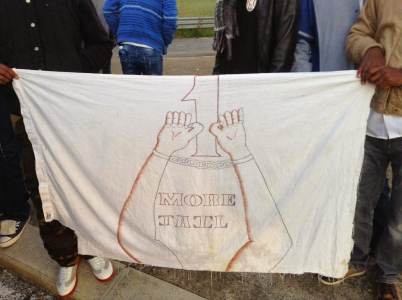Suspended Existence and Resistance at the CARA (Hosting Centre for Asylum Seekers), Mineo
The CARA (Centro di Accoglienza per Richiedenti Asilo: Hosting Centre for Asylum Seekers) opened in Mineo, Catania on the 18th March 2011. It was opened in response to the “the nation’s state of emergency,” declared by the then Berlusconi government in response to the migration towards mainland Europe from the revolutions underway in North African countries and the war in Lybia. According to government designs the “Villaggio della Solidarieta” in Mineo would provide an Italian model of a European refugee centre. It recycled a gated community modelled on the layout of an American town, which had been purpose built for the American military, who were due to leave in 2011 on the expiry of their contract.
The “five stars” of the residence transformed into a CARA and its 404 small villas immersed in a countryside of orange groves, have caused quite a stir on parliament websites, in the declarations of observers and in the EU parliament in recent months. These glimpses of the Mineo CARA experience viewed from afar selectively and smugly captured the buildings and countryside, whilst neglecting the lives of the inhabitants and ignoring how their lives were unravelling in this protracted suspension. The administrators from Caltagirone were asked to do the same thing, to ignore these people when, advisor after advisor from ex- Minister Maroni’s team recommended that the centre was not referred to in terms of the “golden prison” and they promised to compensate the 15 local councils in the area with PonSicurezza funds for the effects of outsiders being brought in.
Nonetheless, activists and journalists who have worked inside Mineo have documented the segregation which the asylum seekers are subjected to as a “five star hell”, a “non place”, a “golden prison”, a “luxury concentration camp” and have paid testament to the over 5,000 people who have passed through the CARA since March 2011. The asylum seekers and refugees who live in Mineo, refer to it as a “camp”, which conveys the sense of the precariousness of their “camp lives” which they have experienced in this Italian “Refugee Centre”, or “prison yard” as one of the refugees has come to call it. This serves to emphasize the capture of existence that this suspension produces.
This piece is presented as a collection of stories yet also a documentation of dates and accounts to record the coping strategies that the migrants have developed against the violation of power, the artificial economy, the protests and the checks which make up daily life at the Mineo CARA: from the canteen menu to the irregularity of many of the women’s menstruation cycles; from the bus service that goes to Catania to the amount of time it actually takes to get to the bus stop from the centre; from the paradoxical concept of “pocket money” to food poisoning; from the endless cigarette breaks taken by the Commission during official hearings to the absence of cultural mediators who can competently translate the migrants’ stories; from the disconcerting range of products on offer in the centre’s bazar to the prohibited products that go in and out of the centre….just to give a few examples.
Report of 12 pages: read complete report from storiemigranti.org

